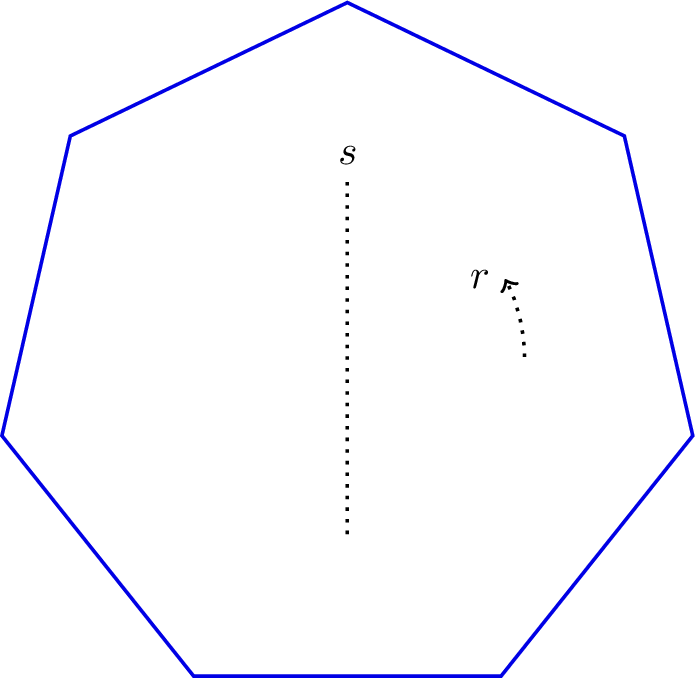1.1 Definitions and first examples
Let be a field (we will almost always take ), and let be a group.
Definition 1.1.
A representation of over is a pair where the
-
•
is a vector space over and
-
•
is a group homomorphism.
The dimension of the representation is the dimension of . We will very often say that is a representation of , or that is a representation of , without mentioning the other part of the definition.
There is another way to think of this. Suppose that is a representation of . Then we define an action of on by . This is an action because is a homomorphism, and it is linear, meaning that for every the map taking to is a linear map. Conversely, given a linear action of on , we can define by . In other words:
A representation of is a linear action on a vector space.
We will often use and interchangeably.
If a basis is given for , then an (invertible) linear map is just the same thing as an (invertible) matrix, where . So, once you choose a basis, a representation is just the same as a homomorphism . In particular:
A one-dimensional representation of is the same as a homomorphism .
Example 1.2.
Let . Recall that there is a homomorphism
taking a permutation to its sign. As this gives a one-dimensional representation of called the sign representation.
Example 1.3.
If is any vector space, then we can always take to be the homomorphism sending every element to the identity. We call this the trivial representation on .
Example 1.4.
Suppose that . Then, if is a representation of it is completely determined by and the invertible linear map (which can be anything). This is because we then have
Thus a representation of is just a vector space together with an invertible linear map from to itself.
We can push this a bit further. Suppose that is a cyclic group of order with generator so
and . Then a representation of is again determined by and which can be any linear map such that .
One source of more interesting examples is geometry.
Example 1.5.
Let be the dihedral group of order the group of symmetries (rotations and reflections) of a regular -gon — see Figure 1. Since each rotation/reflection is an invertible linear map from we get a representation of on . Letting be rotation by and be reflection in the vertical axis, has the presentation
As an explicit homomorphism we have (with )

Example 1.6.
Let . You might remember that this is isomorphic to the group of symmetries (rotations/reflections) of the regular tetrahedron in . We therefore get a representation
It would be a slightly unpleasant exercise to work the matrices out explicitly.
Note that is also isomorphic to the group of rotations of the cube, giving another (different!) three-dimensional representation.
Another source of representations comes from actions of groups on (usually finite) sets.
Example 1.7.
Let and let . Define a representation of on via
where is the standard basis. This is called the permutation representation (over ).
There is a warning here! If you write elements of as , as well you might, then it is not the case that . This actually would define a right action, not a left action. The correct formula is
Definition 1.8.
If is a group acting on a set we consider a -vector space with basis . It has a representation of given by called the permutation representation associated to .
Remark 1.9.
There is another point of view on this, the functional point of view. We didn’t cover this in lectures; as things stand this is optional. For simplicity, let be finite, and define
We give this an action of by the formula
for , , .
Question 1.10.
Why don’t we define ?
Let be the function sending to and everything else to . Then the for are a basis for , and for you can check that
In other words, the behave exactly like the in the permutation representation; when we have a bit more language, we can say that is isomorphic to the permutation representation.
The next example combines geometry and combinatorics.
Example 1.11.
Let be the group of rotations of the cube and let be the set of faces. We can think of an element of the permutation representation as being a way of writing a complex number on each face.
This term is all about finite groups, but next term we will consider representations of Lie groups such as the group of rotations of . These have many applications in physics.
Example 1.12.
In a spherically symmetric situation we might be interested in (smooth) solutions to Laplace’s equation
with radial behaviour for scalars and some integer . Here is the Laplacian
These form a representation of of dimension and in fact the irreducible finite dimensional representations of are exactly those obtained in this way for integers .
The solutions are called spherical harmonics, and representation theory can be used to find particularly nice bases of these spaces!
Here is another example:
Example 1.13.
Let and let . Then is a representation of via